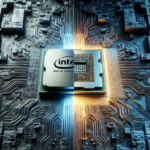The Role of CPUs in Advanced Robotics
The Role of CPUs in Advanced Robotics
In the rapidly evolving field of robotics, the Central Processing Unit (CPU) plays a pivotal role. As the brain of the robot, the CPU is responsible for processing instructions, making decisions, and controlling the various components of the robotic system. This article delves into the multifaceted role of CPUs in advanced robotics, exploring their functions, importance, and future trends.
Understanding the Basics: What is a CPU?
The Central Processing Unit (CPU) is often referred to as the “brain” of a computer or robot. It is a critical component that performs most of the processing inside a computer. The CPU executes instructions from programs, performs calculations, and manages data flow within the system. In robotics, the CPU is essential for interpreting sensor data, executing control algorithms, and managing communication between different parts of the robot.
Components of a CPU
A CPU consists of several key components:
- Arithmetic Logic Unit (ALU): Performs arithmetic and logical operations.
- Control Unit (CU): Directs the operation of the processor.
- Registers: Small, fast storage locations for temporary data.
- Cache: A small amount of high-speed memory for frequently accessed data.
The Role of CPUs in Robotics
In advanced robotics, the CPU is responsible for a wide range of tasks that are crucial for the robot’s functionality and performance. These tasks can be broadly categorized into several areas:
1. Sensor Data Processing
Robots rely on various sensors to perceive their environment. These sensors can include cameras, LIDAR, ultrasonic sensors, and more. The CPU processes the raw data from these sensors to extract meaningful information. For example, in a vision-based system, the CPU might process images to detect objects, recognize patterns, or track movements.
2. Decision Making and Control
Once the sensor data is processed, the CPU uses this information to make decisions. This involves running complex algorithms that determine the robot’s actions. For instance, in an autonomous vehicle, the CPU might decide when to accelerate, brake, or turn based on the processed sensor data. The CPU also controls the actuators and motors to execute these decisions.
3. Communication
Advanced robots often consist of multiple subsystems that need to communicate with each other. The CPU manages this communication, ensuring that data is transmitted and received correctly. This can involve communication between different CPUs in a multi-processor system or between the robot and external devices such as computers or other robots.
4. Real-Time Processing
Many robotic applications require real-time processing, where the CPU must process data and make decisions within a strict time frame. This is critical in applications such as robotic surgery, where delays can have serious consequences. Real-time processing requires a powerful CPU capable of handling high-speed computations and data transfers.
Types of CPUs Used in Robotics
The choice of CPU in a robotic system depends on the specific requirements of the application. Different types of CPUs offer varying levels of performance, power consumption, and cost. Here are some common types of CPUs used in robotics:
1. Microcontrollers
Microcontrollers are compact, low-power CPUs that are often used in simple robotic systems. They integrate a CPU with memory and peripheral interfaces on a single chip. Microcontrollers are suitable for tasks such as controlling motors, reading sensor data, and executing basic control algorithms. Examples include the Arduino and PIC microcontrollers.
2. Embedded Processors
Embedded processors are more powerful than microcontrollers and are used in more complex robotic systems. They offer higher processing power and more advanced features such as multi-core processing and hardware acceleration. Embedded processors are commonly used in applications such as autonomous vehicles, drones, and industrial robots. Examples include the ARM Cortex series and NVIDIA Jetson.
3. General-Purpose CPUs
General-purpose CPUs, such as those found in desktop and laptop computers, are used in high-performance robotic systems that require significant computational power. These CPUs are capable of running complex algorithms, processing large amounts of data, and supporting advanced features such as machine learning and artificial intelligence. Examples include Intel Core and AMD Ryzen processors.
Challenges and Considerations
While CPUs are essential for advanced robotics, there are several challenges and considerations that must be addressed:
1. Power Consumption
Robots, especially mobile robots, have limited power resources. High-performance CPUs can consume significant amounts of power, which can reduce the robot’s operational time. Balancing performance and power consumption is a critical consideration in the design of robotic systems.
2. Heat Dissipation
Powerful CPUs generate heat, which must be managed to prevent overheating and ensure reliable operation. This can be challenging in compact robotic systems where space for cooling solutions is limited.
3. Real-Time Performance
Achieving real-time performance requires careful selection of CPUs and optimization of software. This involves minimizing latency, ensuring timely execution of tasks, and managing resource contention.
4. Integration with Other Components
The CPU must work seamlessly with other components of the robotic system, such as sensors, actuators, and communication interfaces. Ensuring compatibility and efficient communication between these components is essential for the overall performance of the robot.
Future Trends in CPU Technology for Robotics
The field of robotics is constantly evolving, and advancements in CPU technology are driving new capabilities and applications. Here are some future trends to watch:
1. Multi-Core and Parallel Processing
As robotic systems become more complex, there is a growing need for multi-core CPUs that can handle parallel processing. This allows robots to perform multiple tasks simultaneously, improving efficiency and performance.
2. Integration of AI and Machine Learning
Artificial intelligence (AI) and machine learning (ML) are becoming increasingly important in robotics. CPUs with specialized hardware for AI and ML, such as tensor processing units (TPUs), are enabling robots to perform advanced tasks such as object recognition, natural language processing, and autonomous decision-making.
3. Edge Computing
Edge computing involves processing data locally on the robot rather than relying on cloud-based servers. This reduces latency and improves real-time performance. CPUs designed for edge computing are becoming more prevalent in robotic systems.
4. Energy-Efficient Designs
Advancements in CPU design are focusing on improving energy efficiency. This is particularly important for mobile robots that rely on battery power. Energy-efficient CPUs can extend the operational time of robots and reduce the need for frequent recharging.
FAQ
What is the role of a CPU in a robot?
The CPU in a robot acts as the brain, processing instructions, making decisions, and controlling various components. It handles tasks such as sensor data processing, decision making, communication, and real-time processing.
What types of CPUs are used in robotics?
Common types of CPUs used in robotics include microcontrollers, embedded processors, and general-purpose CPUs. The choice depends on the specific requirements of the robotic application.
Why is real-time processing important in robotics?
Real-time processing is crucial in robotics because many applications require timely responses to sensor data and control commands. Delays can lead to suboptimal performance or even dangerous situations, such as in autonomous vehicles or robotic surgery.
What are the challenges of using CPUs in robotics?
Challenges include managing power consumption, heat dissipation, achieving real-time performance, and ensuring integration with other components. Balancing these factors is essential for the effective operation of robotic systems.
How are advancements in CPU technology impacting robotics?
Advancements in CPU technology are enabling new capabilities in robotics, such as multi-core processing, AI and machine learning integration, edge computing, and energy-efficient designs. These advancements are driving the development of more sophisticated and capable robotic systems.
Conclusion
The role of CPUs in advanced robotics is both fundamental and transformative. As the central processing unit, the CPU is responsible for executing instructions, processing sensor data, making decisions, and controlling the robot’s actions. The choice of CPU, whether it be a microcontroller, embedded processor, or general-purpose CPU, depends on the specific requirements of the robotic application.
While there are challenges such as power consumption, heat dissipation, and real-time performance, advancements in CPU technology are continually pushing the boundaries of what robots can achieve. With trends such as multi-core processing, AI integration, edge computing, and energy-efficient designs, the future of robotics looks promising and exciting.
As we continue to innovate and develop more advanced CPUs, the capabilities of robots will expand, leading to new applications and possibilities in various fields, from healthcare and manufacturing to exploration and everyday life.




